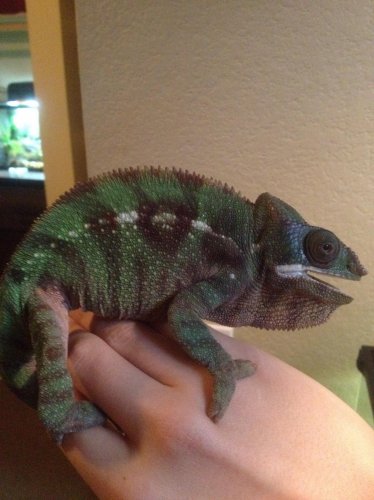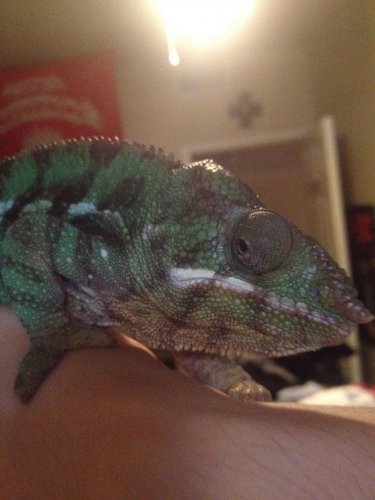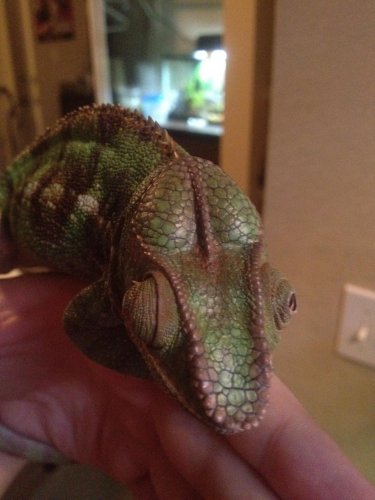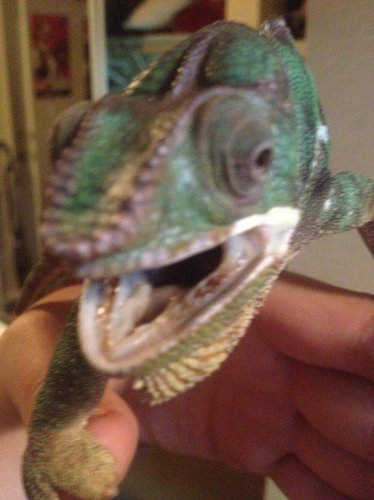Basilisk09
New Member
My male Panther Costello just recently got over stomatitis and still has some brown teeth, but he hasn't been eating at all for about a month now. He still seems up to weight, 150g-ish, and I haven't changed his living style besides improving the water (brita-filtered tap to RO) so I'm just wondering what might have gotten to him now. Someone suggested Gular Edema since I mentioned his gular and between his front legs has been a little "poofy feeling", which might answer why he hasn't eaten. What do you guys think? What can I do for him?
Chameleon Info:
Your Chameleon - Furcifer Pardalis, male, about 1 1/2 years old. I've had him for almost 6 months.
Handling - Never previously, very often since September for treating stomatitis.
Feeding - I've been giving him either superworms or crickets. He has always only eaten superworms (used to be 5 a day or 2 days) and he has shunned crickets, but they're offered. I gutload both with carrots or green gut-load cubes.
Supplements - I mixed a calucium/d3 powder with a small amount of multivitamin in a salt shaker. I dust every other feeding.
Watering - I mist his cage with a pump mister, and spray for about a minute, or until everything has a film of water on it, at 10 or 11AM and 5 or 6PM. I spray so there are large dropplets on the screen mesh, which is the only water he seems to drink from.
Fecal Description - No recent droppings, but was regular with slightly orange urate from superworms. He has had a fecal test, and it doesn't seem he has parasites.
History - He has recently been to the vet for stomatitis, but otherwise he should have a clean bill of health.
Cage Info:
Cage Type - 2x2x4' mesh cage
Lighting - using 4' uvb for 2 cages and regular dome light with 75 watt florescent bulb.
Temperature - temp ranges from 79-84 degrees F. 12 hour light schedule, 9-9.
Humidity - 50% humidity constant, raising to 77 after misting. Both temp and humidity measured by electronic measuring device that I move occasionally between cages and room.
Plants - Live ficus, fake plants and vines.
Placement - The cage is located at the back of my room next to a window that is closed, blinds down, and sheet over it. There is no traffic outside of my daily chores for all my reptiles. The cage sits on a 3ft table, and sits at its highest at 7ft.
Location - I am in Tempe Arizona.
Chameleon Info:
Your Chameleon - Furcifer Pardalis, male, about 1 1/2 years old. I've had him for almost 6 months.
Handling - Never previously, very often since September for treating stomatitis.
Feeding - I've been giving him either superworms or crickets. He has always only eaten superworms (used to be 5 a day or 2 days) and he has shunned crickets, but they're offered. I gutload both with carrots or green gut-load cubes.
Supplements - I mixed a calucium/d3 powder with a small amount of multivitamin in a salt shaker. I dust every other feeding.
Watering - I mist his cage with a pump mister, and spray for about a minute, or until everything has a film of water on it, at 10 or 11AM and 5 or 6PM. I spray so there are large dropplets on the screen mesh, which is the only water he seems to drink from.
Fecal Description - No recent droppings, but was regular with slightly orange urate from superworms. He has had a fecal test, and it doesn't seem he has parasites.
History - He has recently been to the vet for stomatitis, but otherwise he should have a clean bill of health.
Cage Info:
Cage Type - 2x2x4' mesh cage
Lighting - using 4' uvb for 2 cages and regular dome light with 75 watt florescent bulb.
Temperature - temp ranges from 79-84 degrees F. 12 hour light schedule, 9-9.
Humidity - 50% humidity constant, raising to 77 after misting. Both temp and humidity measured by electronic measuring device that I move occasionally between cages and room.
Plants - Live ficus, fake plants and vines.
Placement - The cage is located at the back of my room next to a window that is closed, blinds down, and sheet over it. There is no traffic outside of my daily chores for all my reptiles. The cage sits on a 3ft table, and sits at its highest at 7ft.
Location - I am in Tempe Arizona.





